First 5 things to do
1. Take the assessment & understand your results
The first thing to do after creating your account is to take Bunch assessment. You have the privilege of being the explorer in your team. It only takes 3-5 minutes, and will tell you a lot about how Bunch works, and how you work.
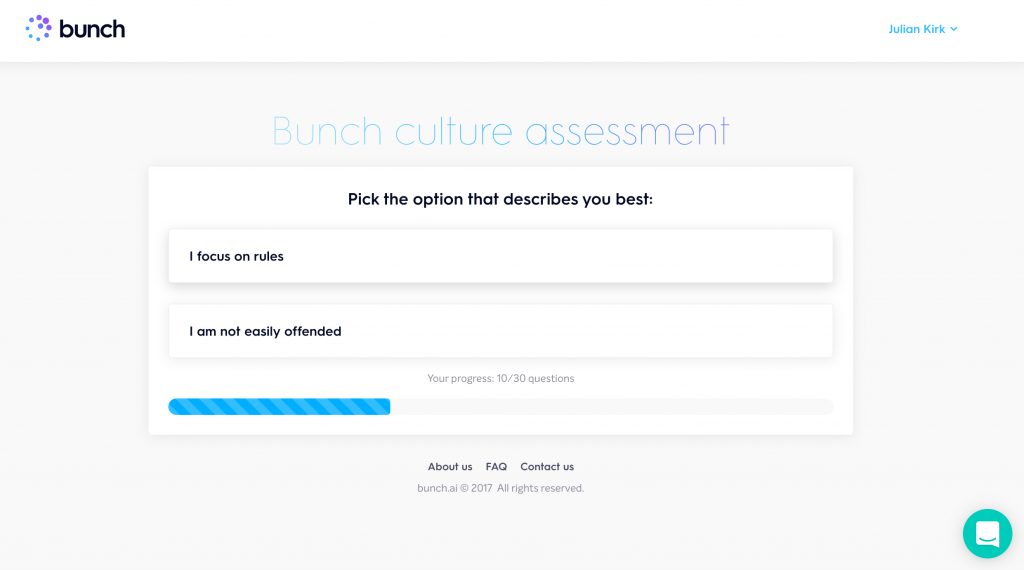
The assessment we use is built on forced-choice testing, a method developed in collaboration with our research partners at Stanford. With this assessment we measure your preferred work styles and norms. The Bunch profile indicated which things you consider good and important when working in a team and which ones less so. As you take the assessment, Bunch maps your profile onto 6 key norm dimensions.

Wondering what these results mean? Check out this article to better understand the value of your profile.
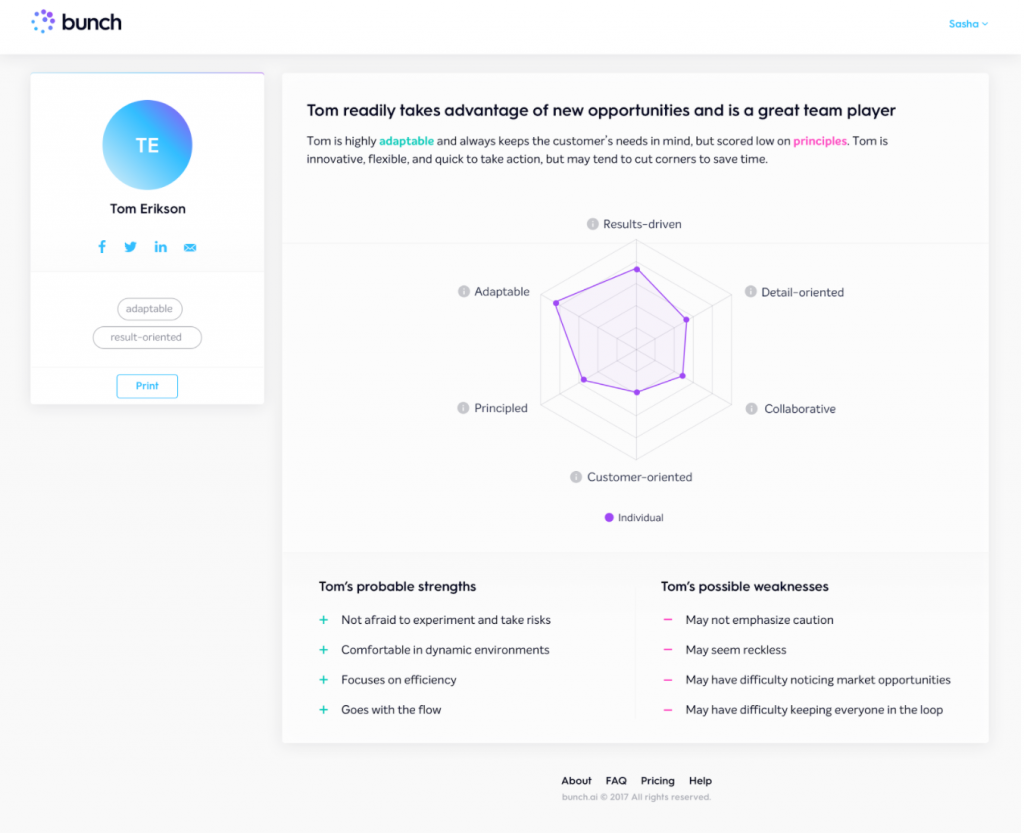
2. Add your teams
Alright, now you know how Bunch works, so you’re ready to set up your teams. While this may seem straightforward, we encourage you to think about each team strategically. For example, you can set up the teams for each department, for specific projects, or for any other groups of people who work closely together. You could even set up teams to test alignment and predict success before assigning a project or initiating collaboration. There are no rules to follow when making teams. Don’t forget, to see the company culture as a whole, just set up a team that includes everyone!
What kinds of things can you learn by creating teams in Bunch? You can answer all these questions and more:
- How are my product and engineering teams working together?
- How has the new manager influenced team dynamics?
- How do I create top performing teams, how do they look different than lowest performing teams?
- How do my product and engineering work together?
- How is our management aligned across different departments?
- Should marketing be more hands-on with the product team, or less?
3. Invite your colleagues to join
Now that your teams are set up, invite your colleagues to join using the link from the team they belong to. If you want some of them to join multiple teams, just send them the links to each of those teams as they register (we know this could be easier, and it will be come October).
Now, what do you say when you invite your teammates? Our main piece of advice is – keep the invite positive and be transparent about why this is happening. At the end of the day, each of us cares about culture and wants to work in a happy, productive team.

Data privacy: Bunch is fully compliant with EU and US regulation on terms and conditions and data privacy. Our terms & conditions include all the important legal aspects with which you can see your employees’ data. Our data is stored on some of the most secure servers in the world that are based in Frankfurt. You own the data, if you ever wish to delete it, you just let us know and we’ll do it (by emailing us at [email protected]).
4. Understand your cultural baseline
As your team takes the assessment you will see bunch compile your team’s culture baseline. This is your existing team culture, the real culture, as measured by data and backed up by science. Now, what does this data mean, and how do you use it to build and develop team culture?

What does my alignment score mean?
Your alignment score is like a grade, but instead of measuring quality of culture (which we couldn’t do, because culture is relative) we measure how consistent your team is in priorities and cultural norms. So, as O’Reilly’s research shows, high scores across 1-2 key cultural dimensions within a team lead to stronger work culture. Likewise, prioritizing everything equally translates to a “vacuous” or empty culture. This is why in the Bunch assessment, you can’t score high on everything – it isn’t a test you can ace or fail. Rather, it shows you your strengths relative to your weaknesses, so you can build strong, focussed culture based on your strongest dimensions.
Does alignment mean no diversity?
![]()
Simply put, no. The alignment score reflects how well your team works together. Alignment does not mean that everyone has the same skills, personality, or attitude. It means that despite the differences in skills, specialization, and role, your team members have something in common that makes them work well as a team.
Bunch encourages the bringing together of people with different personalities, backgrounds, genders, ages, and skill sets, while maintaining cultural alignment on core norms and work priorities to improve overall team performance.
How does all this describe our culture?
Your culture is unique, but just like the vast majority of personalities can be measured through the Big Five personality traits, most cultures can be measured through these six common dimensions. O’Reilly’s model details a clear list of behaviors that correspond with each of the dimensions, so measuring your integrity will allow us to predict your trustworthiness, and measuring your adaptability will enable us to predict your risk taking behavior, etc. We translate them for you into specific examples and behaviors, enabling you to have the best possible conversations with candidates and team members.
Read more on the topic here.
5. Where do I go from here?
Now that you have the culture baseline you are good to start doing strategic hiring and team development in a new way – fully backed up with Bunch data and science. Here’s how most of our customers approach next steps:
- Share the results with your team! You can jump start a conversation on culture goals and priorities by integrating the assessment results with other indicators, such as employee feedback and performance metrics
- Look at alignment! Study the alignment scores of teams and individuals. This information is key to boosting growth and communication.
- Define the first team development initiatives! These can be workshops, meetings, or 1|1s. Fun fact: the faster people engage in the process of shaping culture, the more likely it is culture will shift.
- Build Bunch into your hiring process! Maintain and build cultural alignment with each new hire.
- Purchase Bunch and continue to progress towards your cultural targets by measuring the success of your initiatives
Team Development
1. Understand where your team stands today
As your team takes the assessment you will get a picture of your current culture. The team profile shows you the strongest cultural norms, and the most significant opportunities for team growth.
Your team’s cultural baseline is compiled from your team members’ perspectives. It acts as a map, showing where you are now as a whole, and allowing you to plan cultural changes to help you reach your goals. Unlike some culture building initiatives, this model is based on a data-driven, scientific model that treats team culture as a business asset. Keep in mind that forced-choice testing requires you to prioritize one norm over another, meaning it is impossible to score high on every cultural norm. This helps you and your team focus on the most relevant aspects of your culture that make you unique and help your business thrive.
Read more on the topic here.
2. Define your cultural targets

Target culture will vary from team to team, and company to company. Be transparent and direct about which behaviors you expect from your team. If you agree on those together, and hold each other accountable, you’re moving towards alignment. New features, coming to Bunch in October 2017, will enable you to pick specific deliverables, set priorities, and measure growth over time to see exactly how you’re translating culture into growth.
3. Resolve existing conflicts
Congratulations you’ve encountered a conflict in your team. That’s great news, since you have the opportunity to build trust and relationship between the parties, while resolving the conflict.
The first step in resolving conflicts is understanding the cause. First, create the team for people who are having a conflict. Then look at profiles of the people compared to that team’s profile. If two people are having a conflict, create a team for them and look at the differences in the same manner.
Use the Bunch profile to recognize differences in perspective, priority that may be driving the conflict. Address this clearly with the conflicting parties and pursue to conflict resolution. A great guideline on how to resolve conflicts quickly and efficiently is given by Steli Efit from Close.io here.
4. Address the teams with low alignment
A low alignment score is not a reason to panic. Rather, the profile enables you to have an open conversation with your team based on data and science, rather than personal opinions. Stress to them in this conversation that a culture initiative benefits everyone. Then decide on action steps you can take together.
You can also use this as an opportunity to start a conversation with your management team. Be transparent about why this is important (remember, team culture is a business asset). Finally, be open to input and proactive about reaching a higher alignment score.
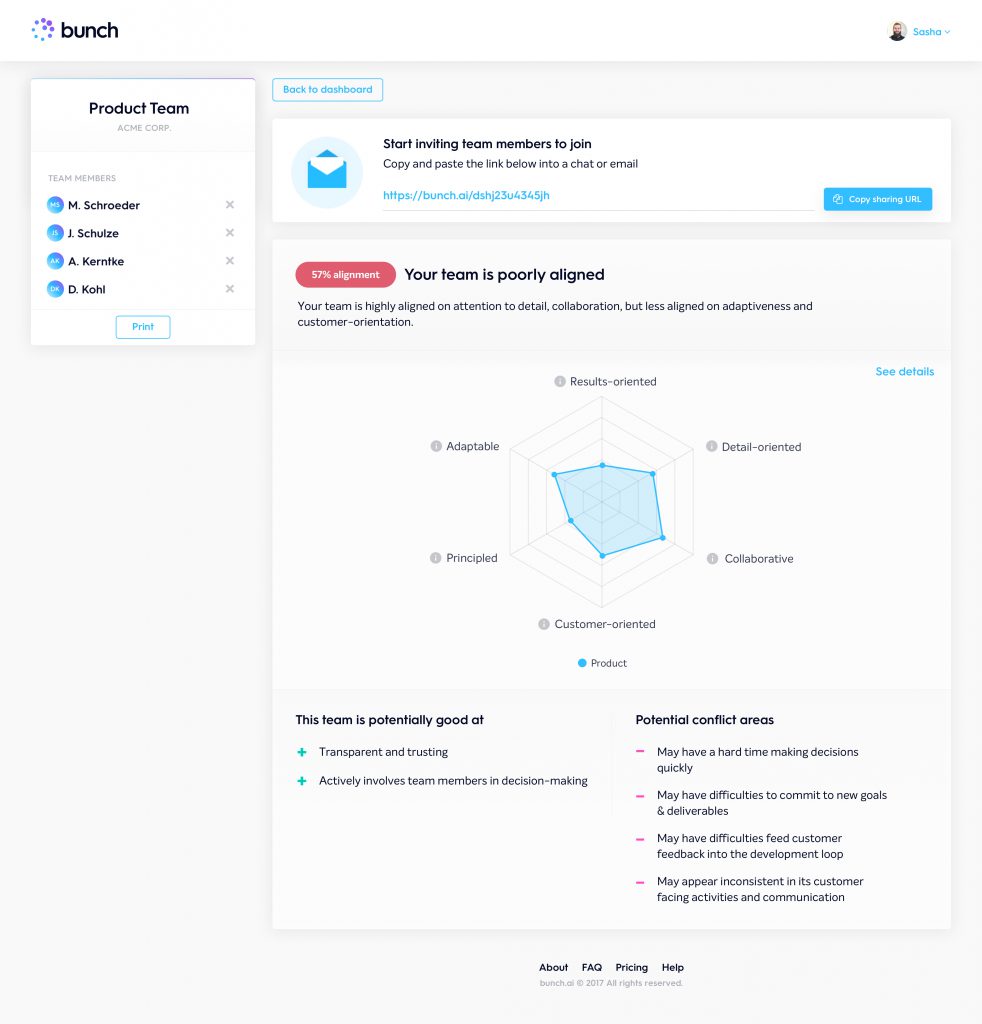
More specifically, share the team profile with the team and have a closer look together at the different profiles of each individual team member. Which differences can you see? Which commonalities? Start with the shared norms: congratulate the team members on having strong points in their team and being alignment on different areas. Reflect together on how this influences their day-to-day life and work together.
Now, look at differences, where do you see misalignments? Can the team members relate to that? How does this influence their day-to-day life and work together? Now it’s time to set cultural targets: Which dimensions do you want to be aligned on? Which behaviors do you want to strengthen? Specify them together with this team and get commitment by writing them down and let every team member confirm that they focus on striving for these behaviors.
5. Mentor & develop the team strategically
 Use the insights from the Bunch team profile to get started with your culture initiatives. Address the potential conflict areas and start moving towards your cultural targets with coaching, mentorship and workshops. For example, fostering results-orientation might mean making your targets more visual in your workspace, or in shared calendars. Aligning on customer orientation could mean creating a database of customer communications that have been addressed, so you can be more consistent in the way you answer FAQ’s.
Use the insights from the Bunch team profile to get started with your culture initiatives. Address the potential conflict areas and start moving towards your cultural targets with coaching, mentorship and workshops. For example, fostering results-orientation might mean making your targets more visual in your workspace, or in shared calendars. Aligning on customer orientation could mean creating a database of customer communications that have been addressed, so you can be more consistent in the way you answer FAQ’s.
You could also bring Bunch into the hiring process and take advantage of its insights from day one, setting expectations both within your team and with potential hires of how you’re hoping their addition will add to the team’s culture.
6. Develop key team members through 1|1s and more
Bunch lets you help every employee become more aligned with the team. You can help them align by giving them targeted coaching, clear direction, & mentorship. Try focussing on their strengths and use 1|1s to enable them and reflect on their progress. The best thing you can give them is transparency and feedback. Specify together with your team, which behaviors you are focused on seeing more from your team members. Hold each other accountable by reflecting regularly how well they were able to display these behaviors. Ask them how you can help them better to live up to the cultural targets.
Hiring? Alignment matters! Let’s set it up:
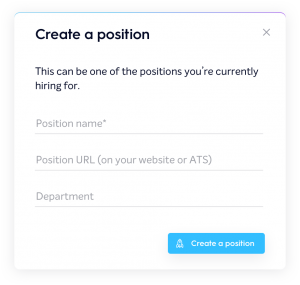
1. Set up your teams & open a new position
The first step in hiring with Bunch is to create your teams. These can be defined as departments, individuals working on a specific project, or any group of people working closely together. You can also set up custom teams consisting of people a new hire would be working closest with, to see how aligned they are.
2. Invite candidates to take the Bunch assessment
Invite the candidates to take the Bunch assessment after screening their CV or LinkedIn profile. You can even integrate the link to the Bunch assessment into your job postings.

This is also a chance for you to show them how much culture matters for your company, and that you want to make sure they fit well and feel setup for success if they join the team. So, ask them to tell you a little bit more about how they work, what their priorities are, and what kind of culture suits them best.
Unlike many other tests, we keep it transparent and deliver value to your candidates as well as to you. When they complete the assessment they will see their own profile, but only you will see the culture match score.
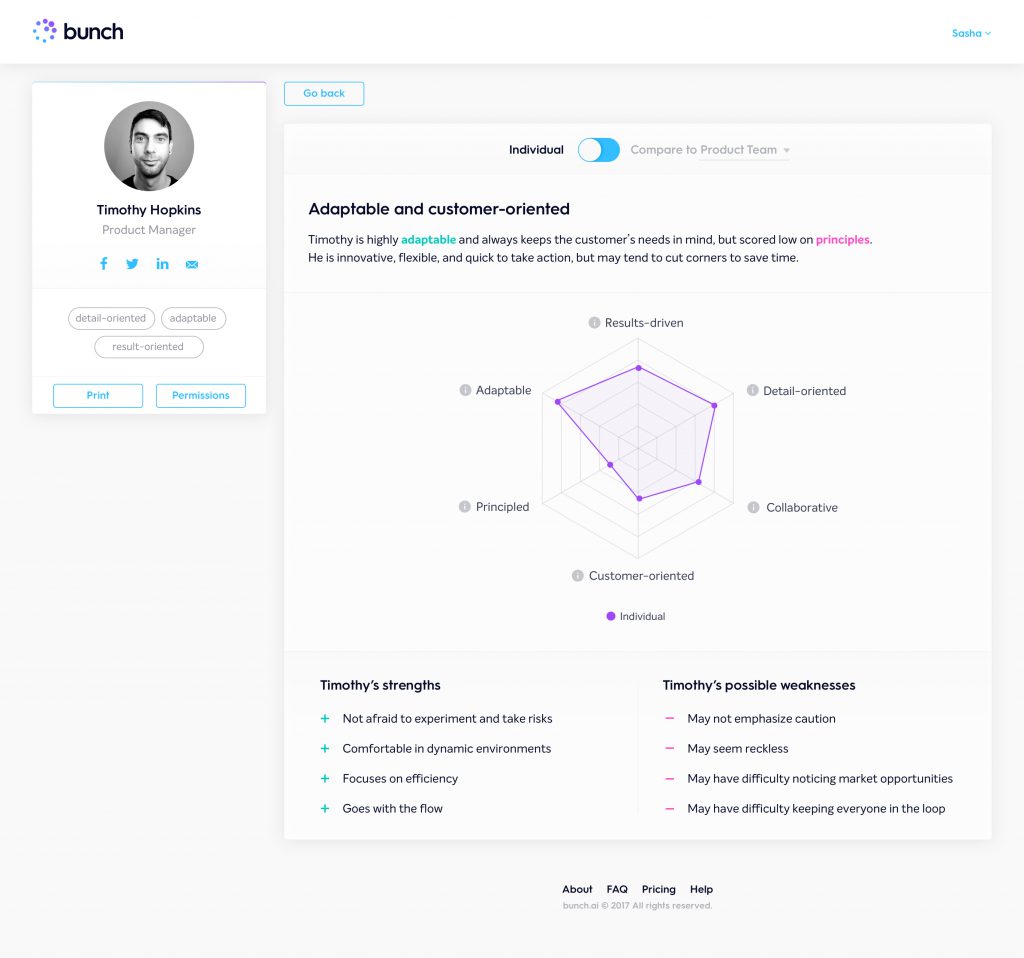
3. Identify and focus on top candidates
As candidates take the assessment, you will immediately see the top people to focus on, because Bunch automatically ranks the candidates by culture fit score. In addition to screening your candidates for hard skills, you can now focus on the people who will align best with your team’s existing culture. Save time by talking to the top culture matching candidates, rather than trying to screen everyone for culture fit during the interview. This will allow you to streamline the process of hiring while at the same time making it more personalized (see below).
4. Wait, but what about creating diverse teams?
It is a part of our mission to enable higher diversity and better inclusion in companies, so Bunch is designed to help ensure strong and diverse teams. Bunch measures your preferred work styles and norms. In other words, we assess what is important to people at work. By teaming people based on what’s important to them instead of their backgrounds, personalities, or skills, we ensure that people with very diverse skillsets and views still pull in the same direction, since they share a certain subset of values and norms that are crucial to your company’s success.
 Diversity of skills in the team
Diversity of skills in the team
Alignment does not mean that everyone works in the same way or that everyone has all the same skills and work attitude. It means that despite the differences in skills, specialization, and role, your team members agree on the most central priorities, values, and norms when it comes to work. That makes them work well as a team. Thus, in each team you can have both alignment and diversity. In fact, cultural alignment helps you to make the most out of diversity, by enabling team members to work towards the same goals while having very different perspectives and approaches.
Demographical Diversity
We measure work style attitudes without attention to any external factor such as race/sex/nationality. In fact, by reviewing the Bunch profile of a candidate before seeing race/gender/nationality, you increase the chance of them being considered for a role, independent of their demographics. Because of this, Bunch helps companies significantly reduce bias when hiring. Ranking candidates by cultural fit (instead of gender, nationality, or educational background) enables both HRs and hiring managers to focus on candidates with high team fit rather than on finding the certain type of profile that a company usually hires. This is especially important for creating diverse leadership teams.
5. Talk to top candidates in a personalized way
Ranking candidates by culture fit doesn’t replace or nullify the interview process; quite the opposite in fact. By showing you which candidates to focus on, Bunch allows you to have more personal, productive interviews with the handful of candidates that would be the best culture fit for your team.
 Using the Bunch profile allows you to see what each candidate will bring to your existing team culture, from possible benefits to potential conflicts. The assessment results also show alignments and misalignments with the team as a whole, and to the smaller teams this candidate might be working with. This will help you backup your gut feeling with data and science. Use the Bunch profile alongside the resume during the interview process to set the right expectations both for the candidate and the team.
Using the Bunch profile allows you to see what each candidate will bring to your existing team culture, from possible benefits to potential conflicts. The assessment results also show alignments and misalignments with the team as a whole, and to the smaller teams this candidate might be working with. This will help you backup your gut feeling with data and science. Use the Bunch profile alongside the resume during the interview process to set the right expectations both for the candidate and the team.
It also allows you to backup your gut instinct about a candidate with science and data, and guard against the potentially $50k loss that a wrong hire would cost the company.
6. Enhance your employer branding
Bunch is also a great way to show new hires that your company cares about team culture and how they fit into the team as a whole, which most find to be a very positive attribute in a potential workplace.
